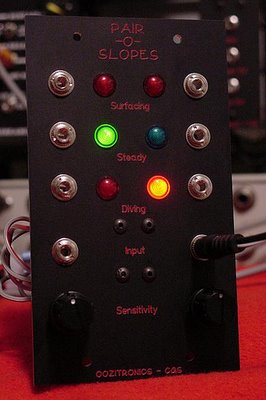
Multiple Arbitrary Function Generator
flickr by
M.M.
Title link takes you to more info on Muff Wiggler.
Details via Grant Richter of
Wiard:
"After years of design and months of work I have a kind of working prototype of the Envelooper MARF. It works, but not perfectly yet. I am still getting the bugs out. This is targeted to the Frac-Rac format.
MARF stands for "Multiple Arbitrary Function Generator". One of the shortcomings of modular synthesis is the lack of complex controllers for modules. To generate a complex control function now, you have to sum together multiple envelopes and LFOs. The Envelooper allows you to draw complex control functions visually, with enough points to reproduce the effect of summing multiple envelopes and LFOs. It also stores pitches like a sequencer, and you can draw an envelope in channel 4 for each pitch.
The Envelooper is designed to support true "gestural" synthesis where a single key press or button push can produce control signals for a complete musical gesture. Multiple gestures are stored in different Banks and can be selected by voltage control. Using a black and white keyboard, you can select and trigger gestures with just the keyboard. The Envelooper also has a "Loop" switch that sets it to free running loop without needing a gate or trigger.
The Envelooper is modeled after an ADSR envelope generator. For the Envelooper, each segment of the A, D, S and R is four 256 byte pages stored in a PROM, for a total of 1024 bytes for each envelope. Four 8 bit outputs are produced simultaneously with a channel to channel skew of an inaudible 1 microsecond.
Each ADSR segment has an independent "playback" time control from 1 millisecond to 20 seconds. The shortest total envelope time is 4 milliseconds and the longest is 80 seconds.
The ouputs are calibrated like the Mini-Wave to 1 volt per octave. Two steps = 83.3 millivolts = a semitone. So the table programmer in Wave 256 can be used to program pitch information using actual note names.
The Wave256 software used to program the Waveform City and Mini-Wave is also used to program the Envelooper. The waveforms in a "Wave" are set up like this for the enveloopers four outputs; A1, A2, A3, A4, D1, D2, D3, D4, S1, S2, S3, S4, R1, R2, R3, R4.
The programming rules are as follows; A(ttack) pages start at -128 and end at +128, D(ecay) pages start at +128 and end at 0, S(ustain) pages start and end at zero, Release pages start at 0 and end at -128. Following these programing rules produce envelopes with no audible "splice" when the device switches from one segment to another.
The four outputs are mapped two different ways for East Coast and West Coast patches. For East Coast use, output 1 controls the pitch of the VCO, output 2 controls the waveform, output 3 controls the VCF (Boogie) and output 4 controls the VCA (Borg 2). For West Coast use, output 1 controls the pitch of the VCO, output 2 controls the waveform X, output 3 controls the waveform Y and output 4 controls the lowpass gate.
8 bits has a fair amount of zipper noise, for pitches we want this quantization, but it is a problem for VCAs and other inputs. One of the little known things about Vactrols is that they remove zipper noise. So running an 8 bit signal through a Vactrol smooths out the steps into continuous function. The VCO will have Vactrols or the equivalent on the waveform X and Y inputs to remove zipper noise. The Borg and Boogie filters are based on Vactrols and already remove zipper noise.
I just wanted to post a little note to let everyone know that Wiard R&D will continue to produce ground breaking designs not available anywhere else. For those REALLY interested I have posted the test PROM file in the files section called adsr4.256 Use the Wave256 software to view the segment designs. Please note this is just an experimental file to test ideas, NOT the final file which will ship with the module."
Again, check out
Muff Wiggler for more module mayhem.
 Remember FLAME? Looks like it will be making an appearance at NAMM.
Remember FLAME? Looks like it will be making an appearance at NAMM.
 Remember FLAME? Looks like it will be making an appearance at NAMM.
Remember FLAME? Looks like it will be making an appearance at NAMM. Title link takes you to a pdf via this thread on HC.
Title link takes you to a pdf via this thread on HC. Multiple Arbitrary Function Generator
Multiple Arbitrary Function Generator flickr by M.M.
flickr by M.M.
 Title link takes you to a 1.83M mp3 by daddio of Tapewarm Studio.
Title link takes you to a 1.83M mp3 by daddio of Tapewarm Studio. 











